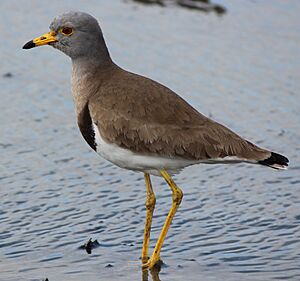Grey-headed lapwing facts for kids
Quick facts for kids Grey-headed lapwing |
|
|---|---|
 |
|
| Conservation status | |
| Scientific classification | |
| Genus: |
Vanellus
|
| Species: |
cinereus
|
| Synonyms | |
|
Hoplopterus cinereus (Blyth, 1842) |
|
The grey-headed lapwing (Vanellus cinereus) is a type of bird called a lapwing. These birds are known for their long legs and loud calls.
They make their homes and have their babies in northeast China and Japan. When winter comes, the lapwings from mainland China fly south. They travel to warmer places like northern Southeast Asia, including parts of India and Cambodia. This journey is called migration. Lapwings from Japan also fly south for winter, often to southern Honshū.
Sometimes, a grey-headed lapwing might fly off course! They have been seen far away in places like Russia, the Philippines, Indonesia, Australia, and even Sweden and England.
What Does a Grey-headed Lapwing Look Like?
The grey-headed lapwing is a medium-sized bird. It is about 34 to 37 centimeters long. That's about the length of a school ruler!
This bird has a grey head and neck. It has a darker grey band across its chest. Its belly is white. The back of the bird is brown. Its rump, which is the area above its tail, is white. The tail itself is black.
When this bird flies, it looks very striking. Its main flight feathers, called primaries, are black. The feathers under its wings are white. The upper part of its wings, called secondaries, are also white. The feathers covering the upper wing are brown.
Both male and female grey-headed lapwings look similar. However, males are usually a bit bigger than females. Young birds have some grey on their white feathers. Their chest band is not as clear. Also, the feathers on their upper body and wings have pale edges. The grey-headed lapwing makes a sharp sound that sounds like chee-it.

How Do Grey-headed Lapwings Live?
These birds build their nests from April to July. They like to nest in wet grasslands. You can also find them near rice fields and the edges of marshlands.
In winter, they live in similar wet areas. They often gather in large groups during this time. Grey-headed lapwings find their food in shallow water. They eat insects, worms, and molluscs.



